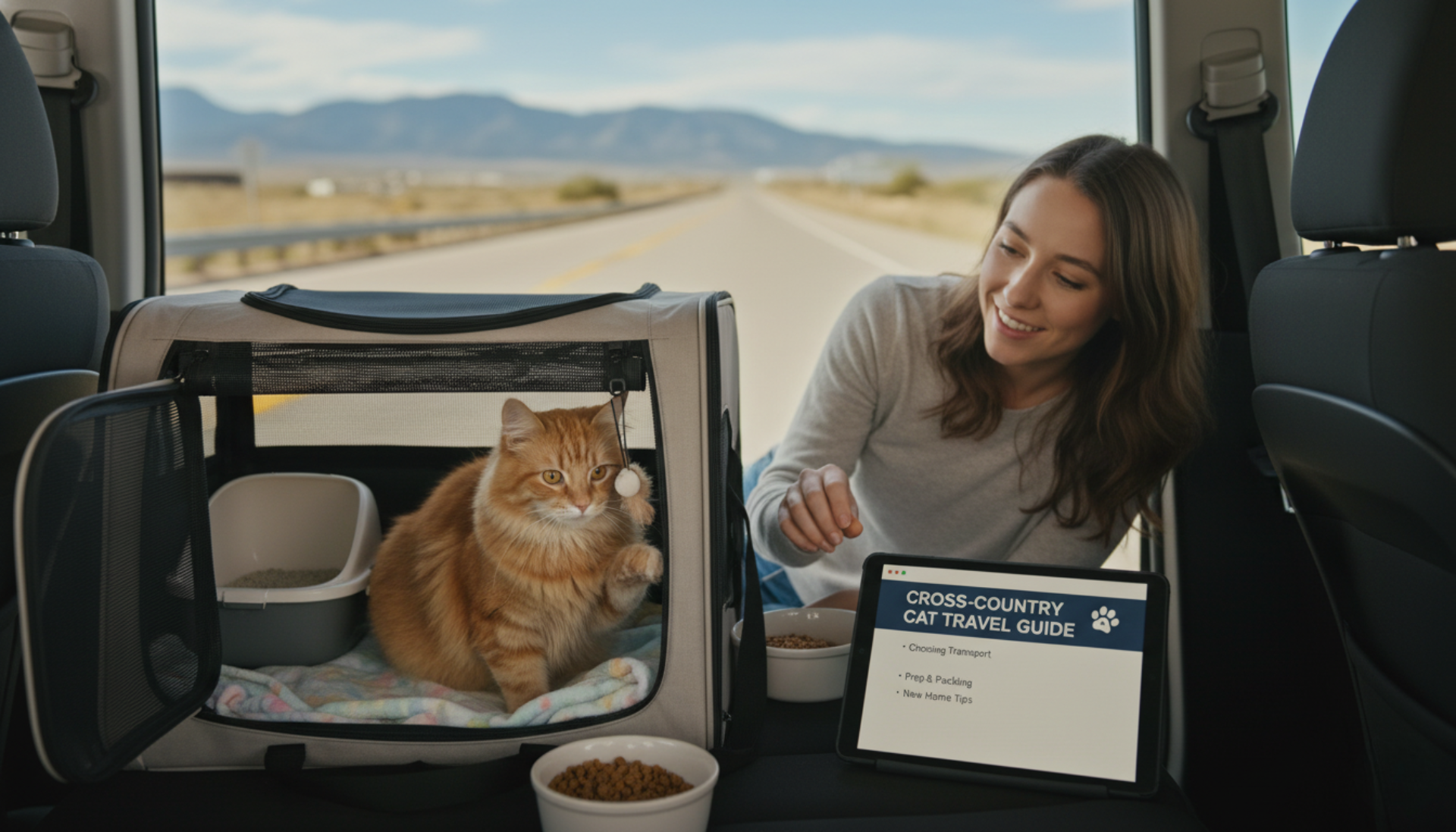How to ship a cat across the country safely can feel like a big mystery at first—especially if you’ve never traveled far with your feline before. You might be wondering, “How will they handle the stress? What if something goes wrong? Can I really make this move without turning my cat’s world upside down?”
The good news is, yes—you absolutely can. With the right preparation, understanding, and a bit of patience, moving your cat across the country can be smooth, safe, and even surprisingly calm. Ground transport tends to be the most cat-friendly option, minimizing noise, motion, and anxiety. It’s all about comfort, consistency, and planning ahead.

In this guide, I’ll walk you through everything you need to know—from why you might need to transport your cat long-distance and how to choose the right travel method to preparing your cat emotionally, gathering the right documents, and helping them settle into their new home.
By the end, you’ll feel confident that your furry companion can travel safely, comfortably, and with as little stress as possible—for both of you.
Why Ship Your Cat Across the Country
There are plenty of reasons—moving for a new job, reuniting with family, or adopting a cat from across the state line. Whatever the reason, I know one thing: peace of mind matters.
Shipping your cat professionally means fewer surprises and less stress—for both of you. My clients often tell me they’re amazed at how calm their cats are when handled by trained transporters who understand feline behavior. Doing it alone can be nerve-wracking. Working with an expert turns it into a process you can actually trust.
Choosing the Right Transport Option
Ground Transportation
This is my go-to choice for most cats. It’s quiet, climate-controlled, and comfortable. Each cat gets personal attention, food, and hydration breaks. I make regular stops for quick litter breaks, gentle check-ins, and a reassuring scratch behind the ears (if permitted, of course).
Air Transport
Sometimes flying is necessary—long distances, tight timelines, or specific destinations. But let’s be honest: cats aren’t big fans of jet engines. Air travel can be stressful due to temperature shifts and unfamiliar sounds. When I recommend flying, it’s because the benefits outweigh the discomfort—not because I want your cat to earn frequent flyer miles.
Preparing Your Cat for Long-Distance Travel
Preparation is everything. I always tell my clients: start early.
First, visit your vet. Make sure vaccinations are up to date and request a health certificate—that’s your cat’s official travel passport. If your cat isn’t microchipped, now’s a good time.
Then, introduce the travel crate gradually. Leave it open at home with a cozy blanket or a familiar toy inside. Cats are suspicious creatures—winning their trust with that crate early makes a world of difference.
On travel day, pack essentials: food, water, and something that smells like home. I also suggest feeding a smaller meal before departure to avoid motion sickness.
Safe Cat Shipping: What to Expect During Transport
I use climate-controlled vehicles and secure, padded crates for each cat. Comfort and safety come first. I keep the ride smooth and the temperature steady—think “spa day,” not “roller coaster.”
Throughout the journey, I send photo or text updates so owners know how their cat is doing. I make regular stops for feeding, litter breaks, and hydration. My rule: if I wouldn’t travel that way, your cat won’t either.
Required Documentation and Health Certification
To keep everything legal and smooth, you’ll need:
- A veterinary health certificate (usually dated within 10 days of travel)
- Vaccination records
- Identification tags and microchip details
- Emergency contact info
If you’re moving internationally, expect a few extra forms and timeline requirements. Domestic travel, thankfully, is much simpler.
Understanding Cat Shipping Costs
Prices depend on distance, service type, and schedule. A coast-to-coast move typically ranges between several hundred and a couple thousand dollars, depending on comfort level and timing.
I always encourage clients to request a personalized quote—no two cats (or routes) are alike. My goal is transparency: you’ll always know what’s included and why.
After-Arrival Care: Helping Your Cat Settle In
When you get home, give your cat space. Set up a quiet room with food, water, and familiar bedding. Let them explore slowly—cats need time to feel in control again.
If they hide under the bed, don’t worry. It’s part of their process. Within a day or two, they’ll be back to their usual routines—probably ignoring you just enough to remind you who’s in charge.
Questions I Often Get
What documents are needed?
You’ll need a health certificate, vaccination records, and ID info.
How far in advance should I book?
Ideally, 2–4 weeks before travel. More during busy seasons.
Can I ship more than one cat?
Yes, and I often do—but each cat has its own secure space.
Should I sedate my cat?
Usually not. Sedation can cause health risks during travel. Calm handling works better.
Can I track my cat’s journey?
Absolutely. I send updates and photos throughout the trip.
Why Choose Professional Cat Transport Services
Experience matters. I’ve driven thousands of miles with cats of every temperament—from stoic travelers to drama queens. My job is to make sure each one feels safe, comfortable, and cared for the entire way.
Choosing a certified transporter means less stress, better communication, and peace of mind that your furry companion is in good hands.
If you’re planning a move soon, let’s chat. I’ll walk you through every step and provide a detailed quote tailored to your route and your cat’s needs.
Conclusion
With careful planning and the right professional help, shipping your cat across the country doesn’t have to be stressful. I’ve seen hundreds of cats travel safely and arrive calm, curious, and ready to explore their new home.
Your cat’s comfort is my priority—and my favorite part of every trip is seeing that happy reunion at the end. Learn more.
